This easy bibimbap with ground beef is one of our favorite go-to Korean meals. You can easily substitute ingredients and customize it to your preference. This bibimbap is made extra easy with ground beef. No marinating need and it still tastes just as good!
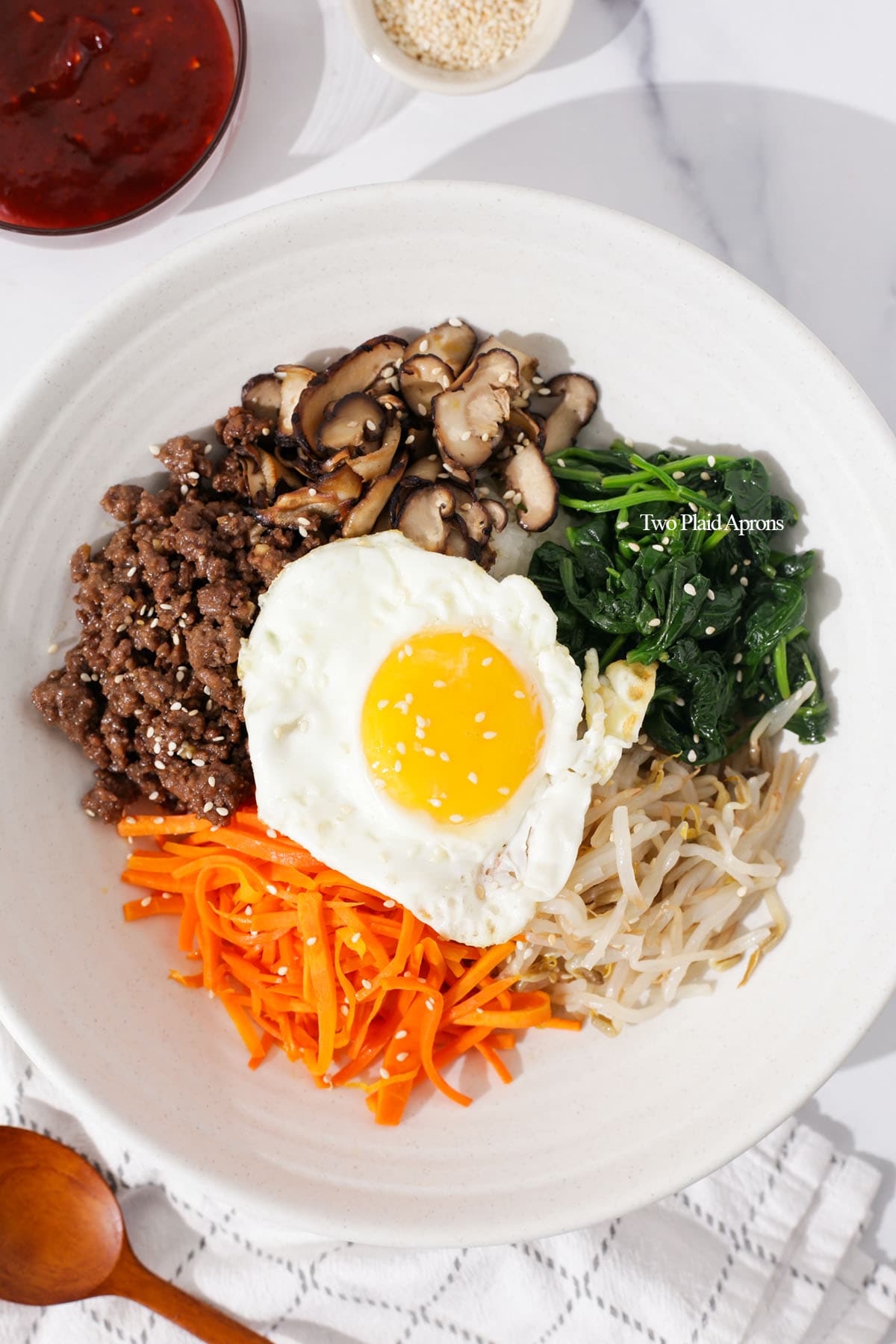
Bibimbap is known in Korean households as the clean-out-the-fridge meal because any ingredient is fair play and usually goes well in the mixed rice bowl. In most Korean households, banchan like naemul (aka seasoned vegetables) are made on the weekly basis. So repurposing those banchan to make bibimbap is a no-brainer.
For those of us that don't always keep a variety of banchan in our fridge, we can still easily make bibimbap, like ones served at Korean restaurants! This recipe will show you an easy way to make tasty bibimbap with ground beef so that you don't have to marinate the beef, and it'll still taste amazing!
If you liked this ground beef bibimbap, you may also like our other classic Korean dishes like jajangmyeon (Korean black bean noodles), kimchi jjigae, japchae (Korean glass noodle stir fry), and beef bulgogi with vegetables.
Jump to:
What is bibimbap?
Bibimbap, or Korean mixed rice bowl, is a classic Korean meal with rice as a base and topped with naemul (seasoned vegetables), meat (usually beef), fried egg, and a sweet and spicy gochujang based sauce.
This Korean rice bowl is ultimately a clean-out-the-fridge meal that ,utilizes leftover banchan, including naemul, to quickly make a hearty, filling meal. Most Korean families make a variety of banchan/side dishes on a weekly basis, so repurposing side dishes that are on their last days helps prevent food wasting and saves time on cooking.
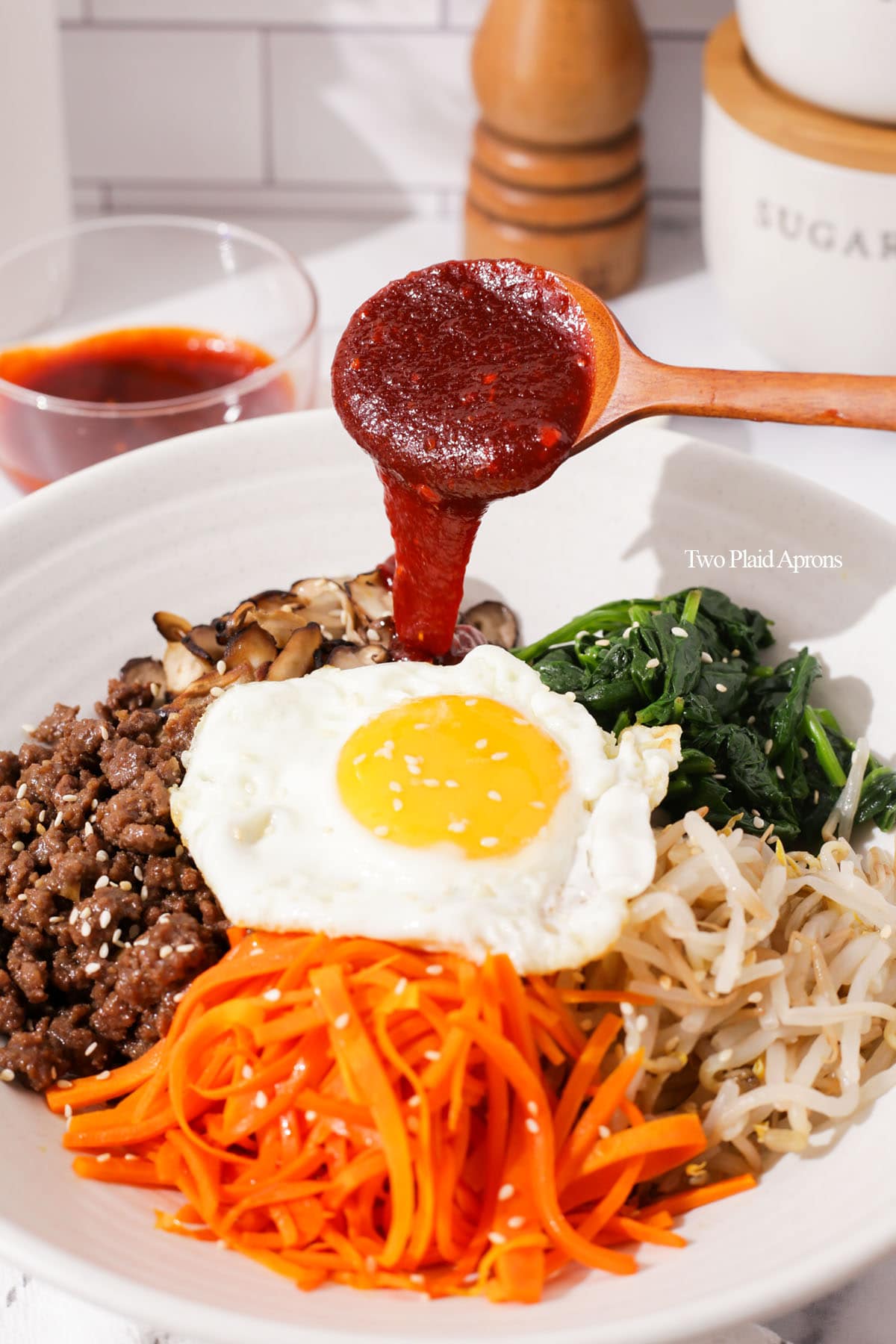
Bibimbap topping ideas
In Korean households, bibimbap is made leftover side dishes (banchan) and whatever leftover ingredients are fair game as well. The list below are some of the most common toppings for bibimbap that you can find at Korean restaurants, but don't let it limit you!
- Blanched and lightly seasoned bean sprouts (both mung bean sprouts or soy bean sprouts)
- Blanched and lightly seasoned spinach
- Sautéed and lightly seasoned carrots, mushrooms, and corn
- Kimchi of any kind
- Fresh vegetables like lettuce and purple cabbage
- Marinated meats and ground meat (usually beef)
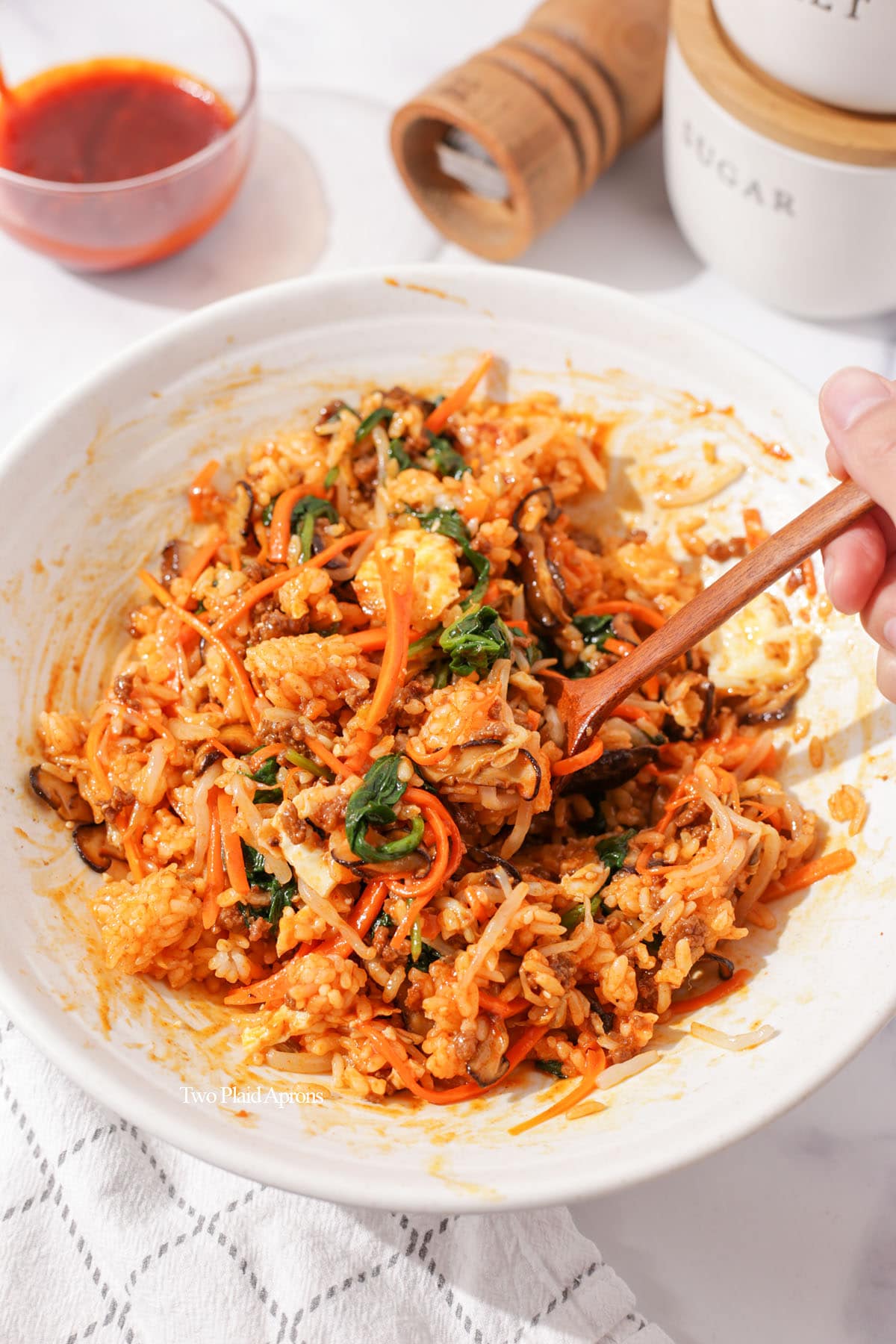
Ingredients
Please scroll down to the recipe card for the ingredient quantities!
- Cooked white rice - You can use more or less to your personal preference. We suggest about 1 cup cooked rice per person. If you prefer, you can also use your preferred rice, such as mixed grain rice or brown rice.
- Carrot, mushrooms, bean sprout, and spinach - These are the vegetables we recommend for our bibimbap for color and texture. But feel free to substitute for what you have or prefer.
- Ground beef - We usually use 80/20 (80 percent lean) ground beef because that's the best balance for both flavor and texture.
- Egg - For the fried egg on top.
- Garlic - Fresh garlic is used for both the ground beef sauce/marinade and the bibimbap sauce.
- Gochujang - Also known as Korean red pepper paste. Gochujang is a Korean pantry staple. It's a little sweet, savory, spicy and the base of bibimbap sauce. Depending on the brand, the gochujang could be more or less spicy.
- Soy sauce - The sauce base for the ground meat. We used low sodium soy sauce.
- Honey - For adding sweetness to both the ground beef sauce and the bibimbap sauce. Honey is a bit healthier, but you can use regular sugar instead, if you prefer.
- Toasted sesame oil - An Asian pantry classic! A little sesame oil is used in all of the bibimbap components to give the dish some toasted nutty flavor.
- Salt - For lightly seasoning the vegetables.
- Sesame seed and green onion (optional for garnish)
- Oil for cooking
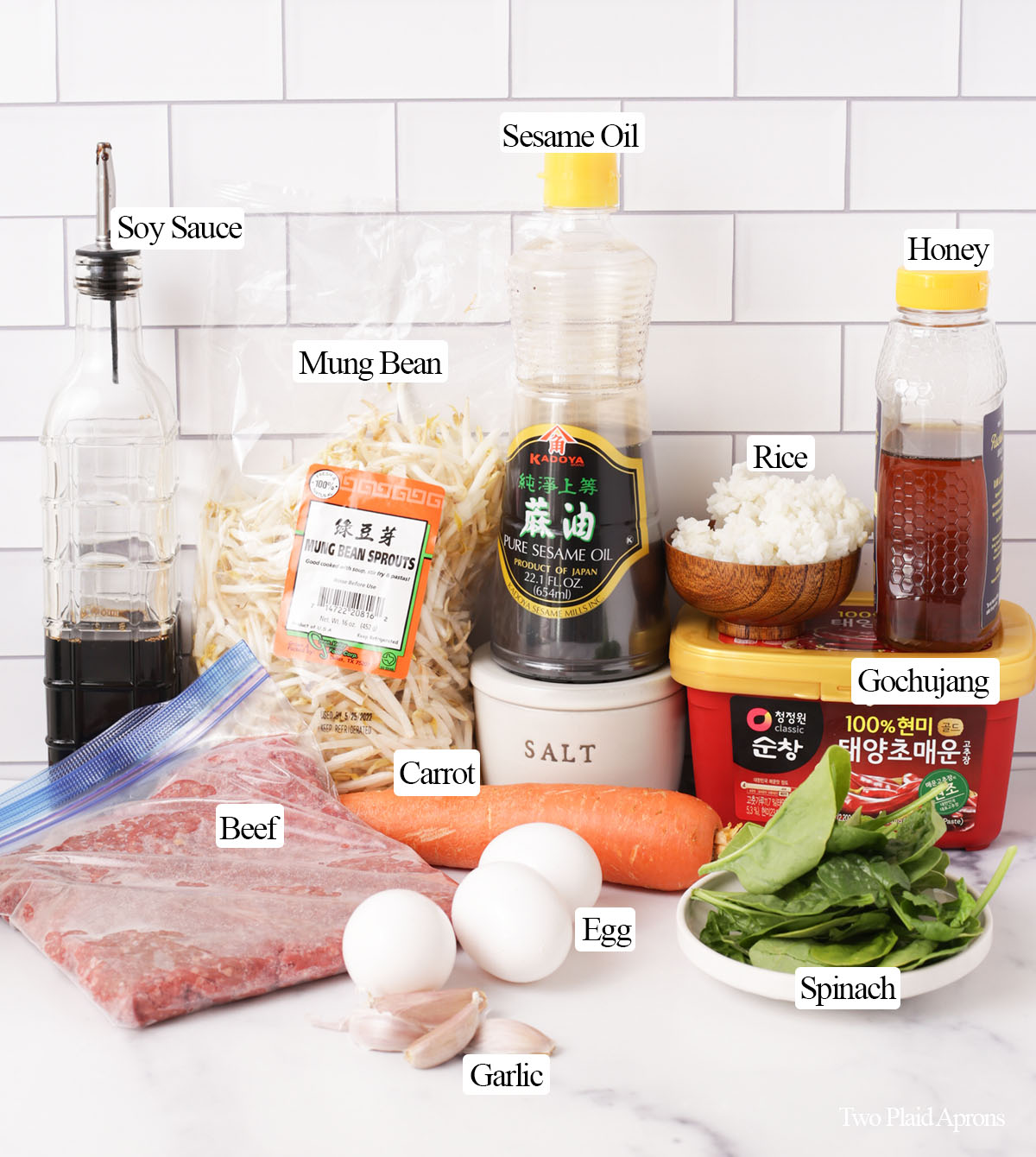
How to make bibimbap with ground beef
Make the bibimbap sauce:
1. In a bowl, mix together gochujang, honey, garlic and toasted sesame oil until well combined. Set aside until needed.

Prepare all the components for the bibimbap:
2. Bring a pot of water to a boil.
For the bean sprouts:
3. Place the bean spouts in the boiling water and cook for about 1 to 2 minutes or until they turn translucent. Use a strainer to fish out all of the bean sprouts and rinse with cold water until completely cooled. Firmly squeeze the bean spouts to extract excess water. Mix the blanched bean sprouts with salt and toasted sesame oil. Set aside until needed.
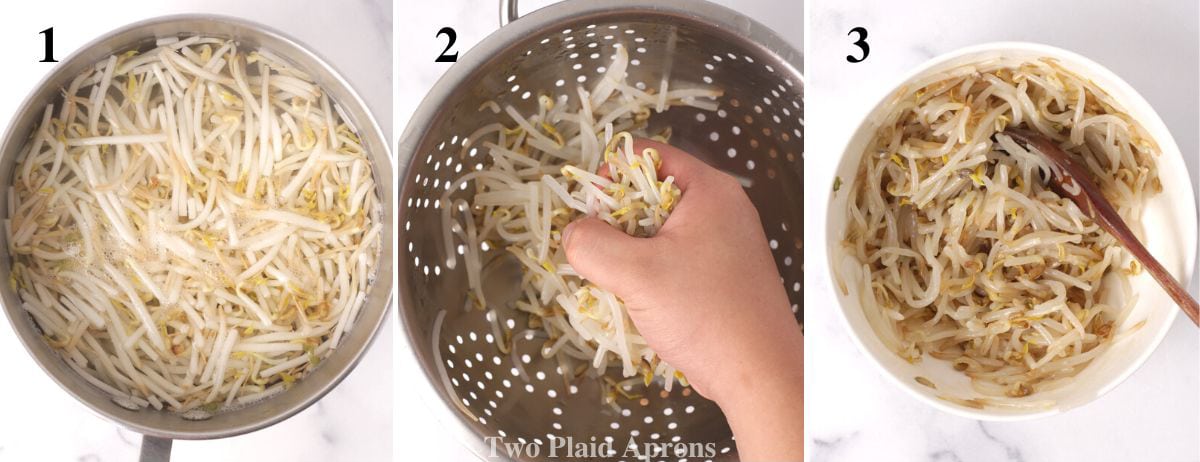
For the spinach:
4. In the same pot of boiling water, add the spinach and cook briefly until they turn bright green and are just wilted, about 15 to 30 seconds. Drain the spinach and rinse with cold water until completely cooled. Firmly squeeze to extract excess water. Mix the blanched spinach with salt and sesame oil. Set aside until needed.
🌟 Pro tip: For both the bean sprouts and the spinach, place a comfortable handful in your hand when squeezing. Too much will make it hard to squeeze and with too little, we tend to squeeze it too hard.
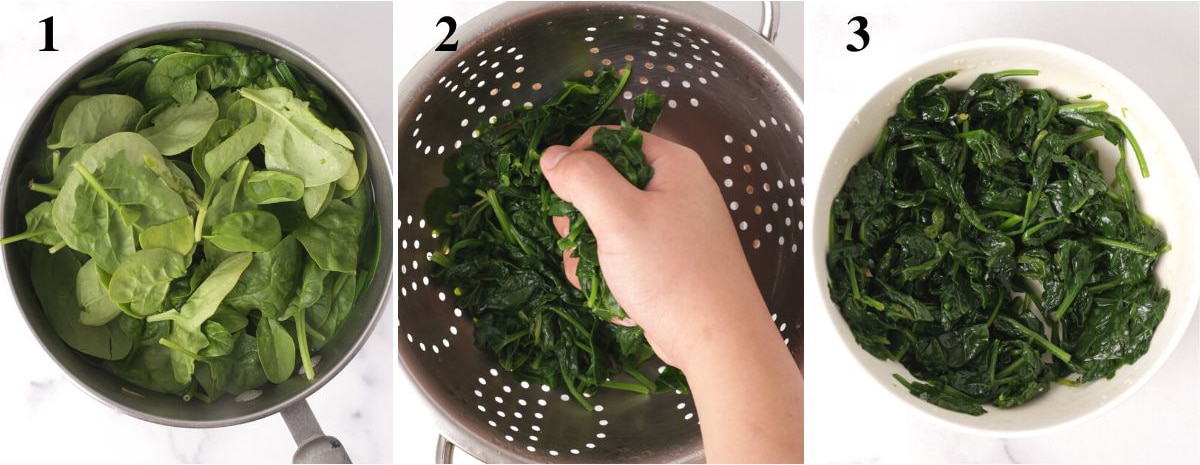
For the ground beef:
5. In a bowl, mix together the soy sauce, honey, garlic, and sesame oil.
6. In a saucepan or medium size pan over medium heat, add the ground beef and cook until the beef is no longer pink. No browning necessary. If the beef released a lot of grease, you can drain it at this time.
7. Once the ground beef is no longer pink, add the prepared sauce and reduce the heat to a simmer, around medium low heat. Let the ground beef simmer in the sauce for about 5 minutes or until the sauce is reduced by a little more than half. Make sure to stir the ground beef occasionally. Set aside and keep warm.
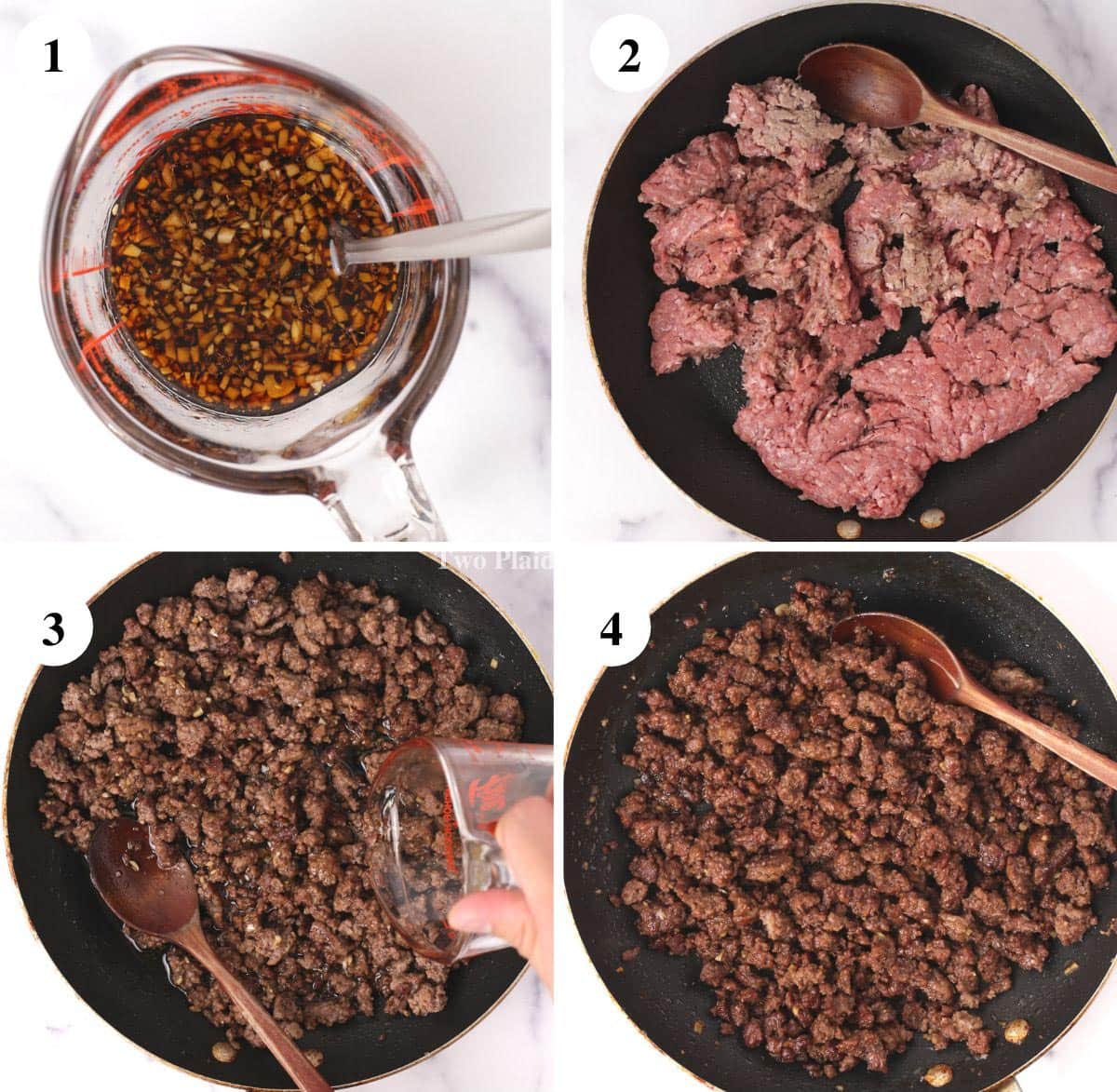
For the mushrooms:
8. In a pan, heat a couple tablespoons of oil over medium high heat. Add the mushrooms and season with salt. Sauté until the mushrooms are just cooked. Drizzle in the sesame oil and toss. Remove from pan and set aside until needed.
For the carrot:
9. In the same pan, heat a couple tablespoons of oil over medium high heat until hot. Add the carrot and season with salt. Sauté until just tender. Drizzle in the sesame oil and toss. Remove from pan and set aside until needed.
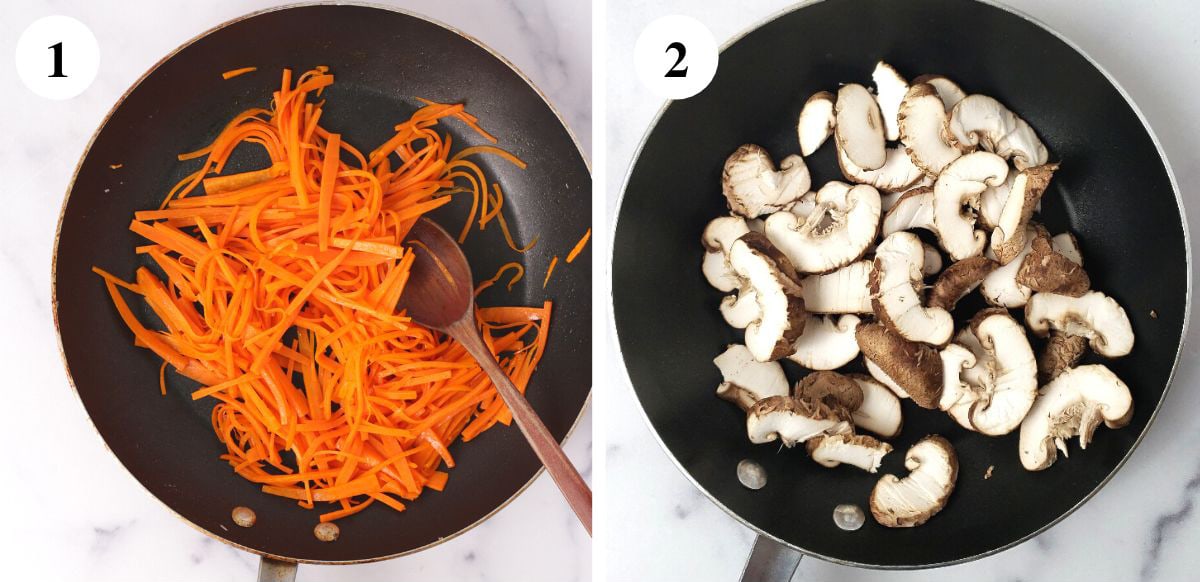
For the fried egg:
10. Wipe off the same pan with a paper towel if needed. Add some oil into the pan and heat over medium high heat until the oil is just starting to smoke. Add the egg(s) and pan fry until the whites are set and the bottom is golden brown. Remove from pan.
🌟 Pro tip: If you fry with a little more oil, you can spoon the hot oil onto the whites while frying the egg. This will help perfectly cook the whites while keeping the yolks perfect and runny.
Assemble the bibimbap:
11. In a large bowl, add your desired amount of rice. Arrange the prepared toppings (bean sprouts, spinach, carrots, mushrooms, and ground beef) around the rice. Place the fried egg on top and garnish with green onions and sesame seeds if you wish. Repeat for as many bowls as you're serving.
12. Add your desired amount of bibimbap sauce. Mix everything up and enjoy!
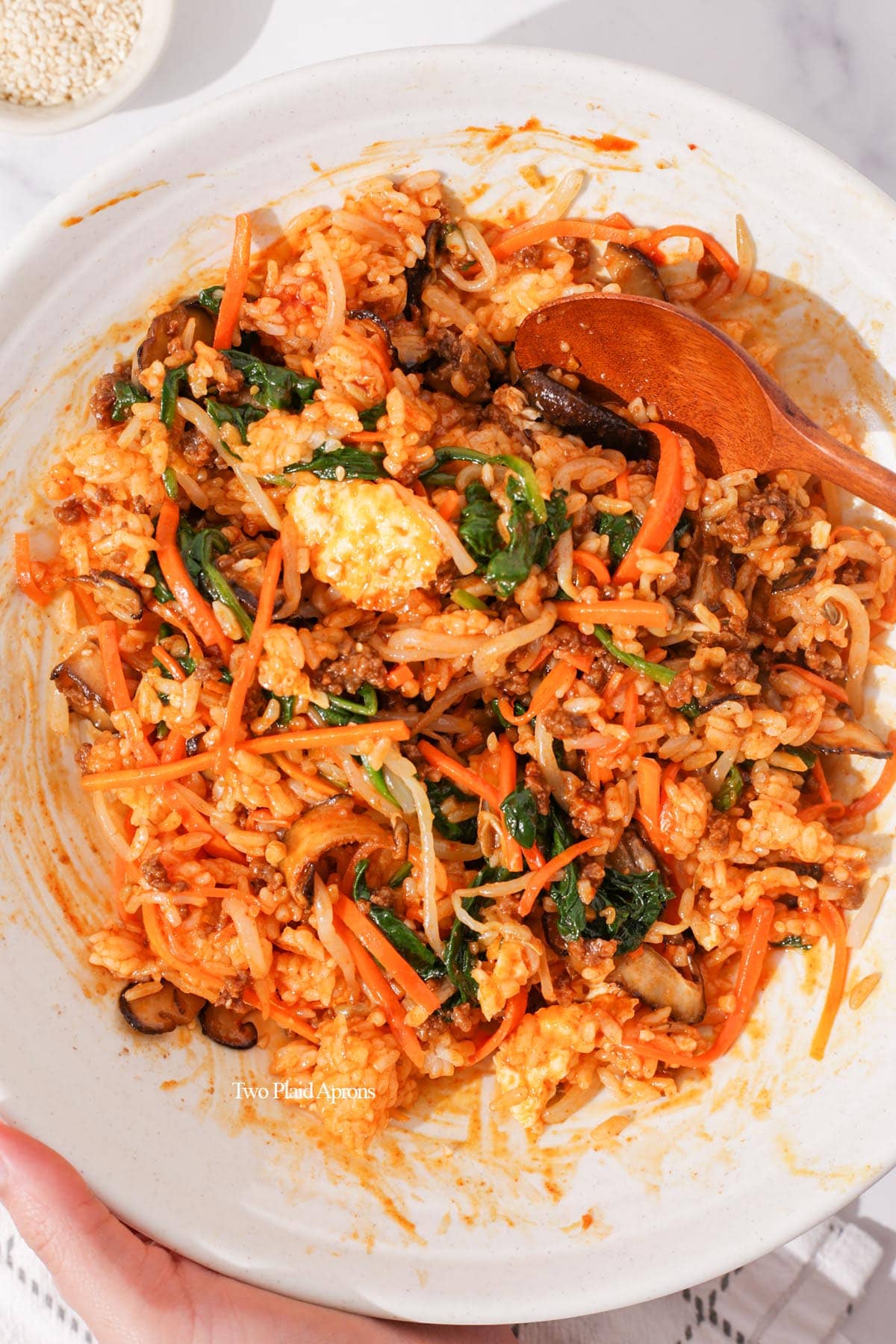
What to eat with bibimbap
You can totally enjoy bibimbap by itself, but have these additional sides are like the cherries on top of a sundae!
- Kimchi - Try out traditional napa cabbage kimchi or fresh kimchi (geotjeori)
- Cucumber sides - Our quick cucumber kimchi and smashed cucumber salad are our favorites!
- Drinks - Our refreshing watermelon soju and grapefruit matcha tonic are out top recommendations.
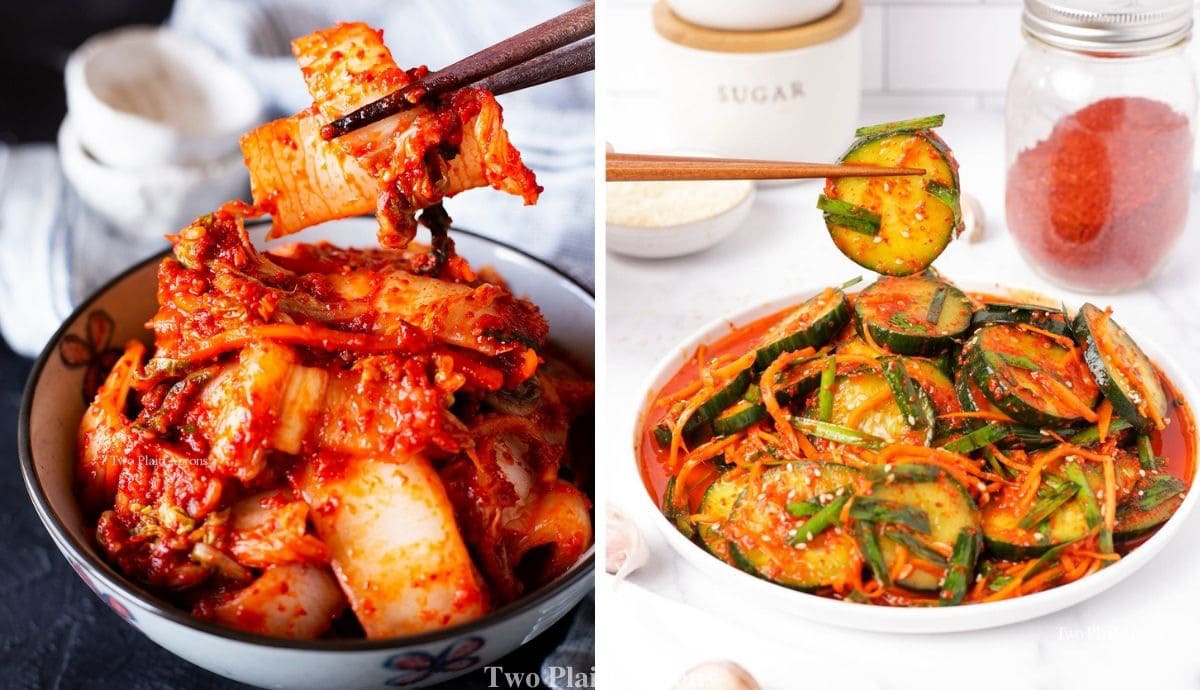
Recipe tips
- Don't over cook the vegetables. The vegetables adds texture and color to the rice bowl.
- When squeezing the vegetables to get rid of excess water from blanching, don't squeeze too hard. Just firm enough to remove excess water, but don't crush the vegetables.
- Don't reduce the sauce for the ground beef too much. You still want to leave some so that the ground beef stays juicy.
- Different brands of gochujang can vary in spiciness. So, if you can't handle too much spice, use a little at a time. You can always add in more.
- Have fun and adjust the toppings to your preference or with what you have. After all, that is why bibimbap is so loved!
- Most of the components can be made a few days ahead of time. So feel free to prepare the ingredients earlier or for meal prepping.

Storage
If you have leftover from your bowl of bibimbap, let it cool completely then wrap it up or transfer to an airtight container. It'll be good for about 3 days in the fridge.
Keep all unused toppings in airtight containers once they're completely cooled, and they'll last for about 4 to 5 days in the fridge, except for the fried egg. It's best to make the fried egg when ready to serve.
Any unused bibimbap sauce will be good for 1 to 2 weeks in the fridge.
Reheating
Already mixed bibimbap can be reheated in the microwave until warmed through.
If you're building your bibimbap the next day, meal prepping, or made the components ahead of time, you only have to make sure the rice is hot and to heat up the carrots, mushrooms, ground beef, and fry an egg. The spinach and bean sprout can be cold. You can heat them up via microwave or on the stovetop.
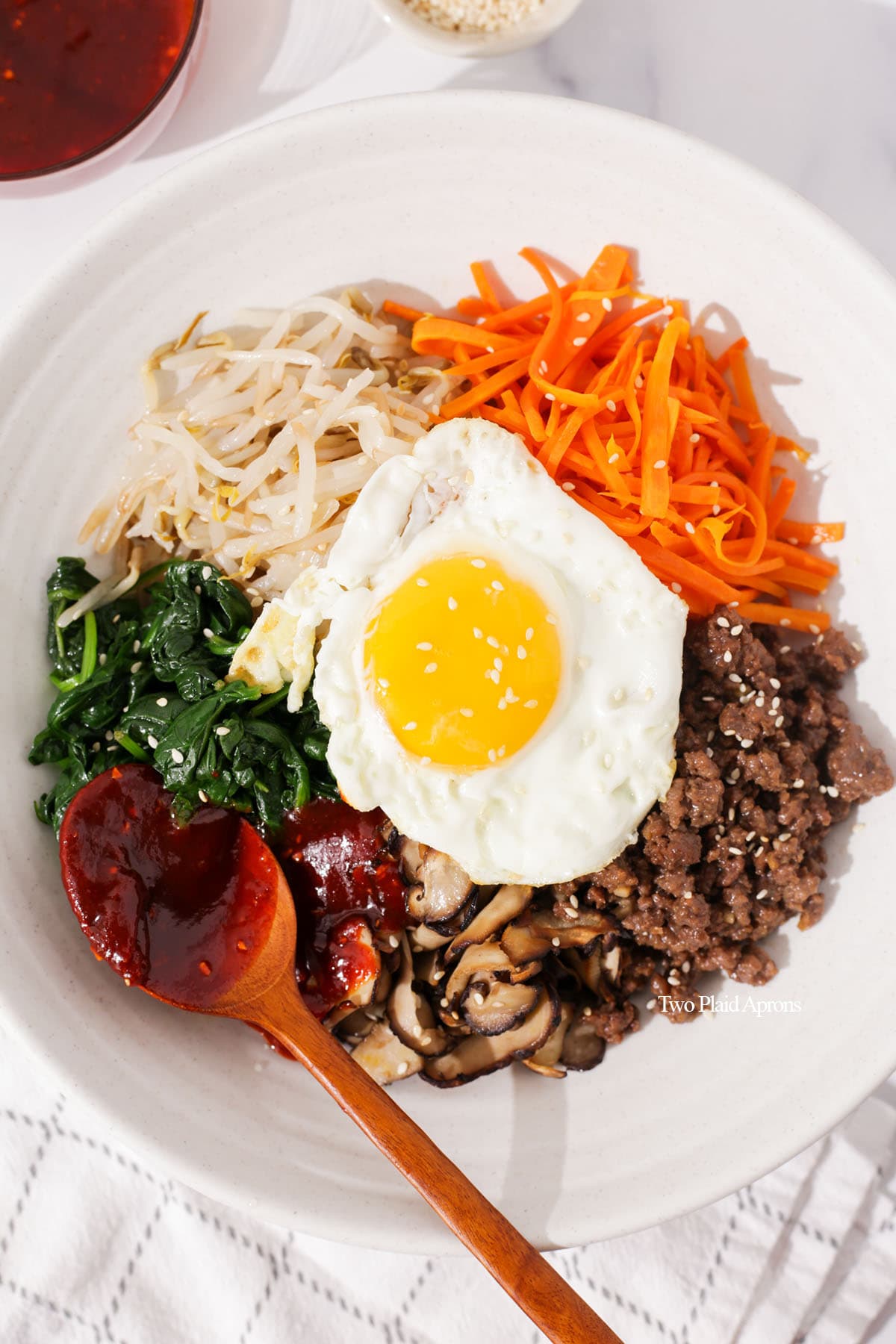
FAQ
Bibimbap translates to "mixed rice" in Korean. So make sure to add your desired amount of bibimbap sauce then mix your ground beef bibimbap together. This way, you'll get a bit of everything in one bite.
Bibimbap should be enjoyed warm. The rice, ground beef, and egg should be hot. The mushrooms and carrots can be either hot or cold. And the spinach and bean sprouts is best used cold. After mixing everything together, the rice bowl will be the perfect temperature.
You can easily make bibimbap sauce by mixing together gochujang (Korean chili pepper paste), honey, garlic, and sesame oil.
Yes! You can make our bibimbap recipe with just the vegetables. Just omit the ground beef and/or egg or you can substitute it for tofu.
Most commonly, bibimbap is made with white rice, but you can use any rice you prefer. Korean purple rice and steamed brown rice are a couple of our favorites when want to feel extra healthy.
Blanching is the process of briefly cooking an ingredient, usually vegetables, in boiling water, then immediately cooling it with ice water or cold water. This cooking process helps minimally cook vegetables and help them retain their color and texture.
If you’ve made this recipe or any recipes from our blog, please tag us on Instagram using #twoplaidaprons! You can also tag us in your Instagram stories using @two_plaid_aprons. We would love to see your creations! It absolutely makes our day! 🥰
📖 Recipe
Easy Bibimbap (Korean Mixed Rice Bowl)
Ingredients
For the bibimbap sauce:
- ¼ cup gochujang (Korean red chili paste)
- 2 tablespoons honey or sugar
- 1 teaspoon garlic minced (about 1 clove)
- 1 teaspoon toasted sesame oil
For the bean sprouts:
- 8 ounces mung bean sprouts or soy bean sprouts
- ½ teaspoon salt
- 1 tablespoon toasted sesame oil
For the spinach:
- 10 ounces baby spinach
- ¼ teaspoon salt
- ½ Tablespoon toasted sesame oil
For the carrots:
- 1 large carrot peeled and cut into juliennes/thin matchsticks
- 2 teaspoon toasted sesame oil
- 1 teaspoon salt
For the mushrooms:
- 8 ounces mushrooms sliced (we used shiitake but use your preferred ones)
- ¼ teaspoon salt
- 1 teaspoon toasted sesame oil
For the ground beef:
- 1 pound ground beef (we use 80/20 ground beef)
- ¼ cup soy sauce
- ¼ cup honey
- 1 tablespoon garlic minced (about 3 cloves)
- 2 teaspoon toasted sesame oil
For the remaining part of the rice bowl:
- 3 cups cooked white rice more or less to your preference
- 3 large eggs
- Green onion thinly sliced (optional for garnish)
- Toasted sesame seed (optional for garnish)
- Oil as needed for cooking
Instructions
For the bibimbap sauce:
- In a bowl, mix together the gochujang, honey, minced garlic, and sesame oil until well combined. Set aside until needed.
For the bibimbap toppings:
- Bring a pot of water to boil.
- Bean sprout:Place the bean sprouts in pot of boiling water for 2 to 3 minutes or until they turn translucent. Use a strainer to fish out the bean sprouts and rinse with cold water until completely cooled. Firmly squeeze the bean sprouts with your hands to remove excess water. Season with salt and sesame oil, then set aside until needed.
- Spinach:In the same pot of boiling water, add the spinach and cook for about 30 seconds or until the spinach is wilted and turns bright green. Drain and rinse the spinach with cold water until completely cooled. Firmly squeeze the spinach with your hands to remove excess water. Season with salt and sesame oil, then set aside until needed.
- Ground beef:Make the sauce by mixing together soy sauce, honey, minced garlic, and sesame oil.In a saucepan/medium pan over medium heat, add the ground beef and cook until no longer pink. Drain the fat if necessary. Then, add the prepared sauce and reduce the heat to keep it at a simmer. Let the ground beef simmer for about 5 minutes or until the sauce is a little more than half reduced. Stir occasionally. Set the ground beef aside and keep warm.
- Mushroom:In a pan over medium high heat, add a couple tablespoons of oil. Once hot, add the mushrooms and season with salt. Sauté until the mushrooms are cooked. Finish with the sesame oil. Remove from the pan and set aside.
- Carrot:In the same pan over medium high heat, add a couple tablespoons of oil. Once hot, add the carrots and season with salt. Cook until just tender and finish with the sesame oil. Remove from the pan and set aside until needed.
- Fry the egg(s):Using the same pan, add some oil and heat it on medium high heat until the oil just starts to smoke. Add the egg(s) and fry until the egg whites are set. Remove from the pan.*If needed, wipe the pan with paper towel to get rid of any bits of vegetables leftover. Fry as many eggs as the number of servings you're making. Fried eggs are best served immediately. If you feel comfortable frying multiple eggs in one pan, feel free to do so.*
Assemble the bibimbap:
- Prepare as many bowls as you are serving. In each bowl, add your desired amount of rice, then arrange the toppings (bean sprouts, spinach, carrots, mushrooms, ground beef) around the rice. Place the fried egg in the center on top of the rice and garnish with the green onion and sesame oil if you wish.
- Add your preferred amount of bibimbap sauce to each bowl. Then, mix everything up to enjoy.
Notes
- This recipe can serve 3 to 4 people.
- Bibimbap is super flexible and customizable. So feel free to substitute any of the toppings for your preferred ingredients or what you have available.
- If you like extra sauce, feel free to double the bibimbap sauce.
- Remove the excess water out of the vegetables. This will prevent the vegetables from sitting in a puddle of soup and diluting the seasonings.


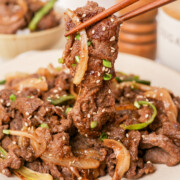

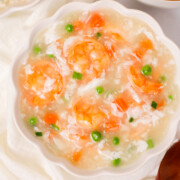
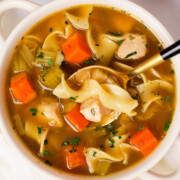
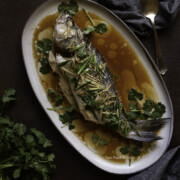


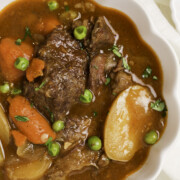
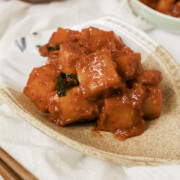
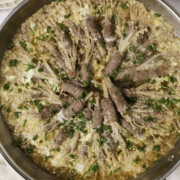
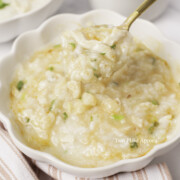
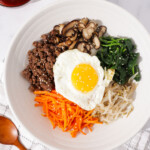




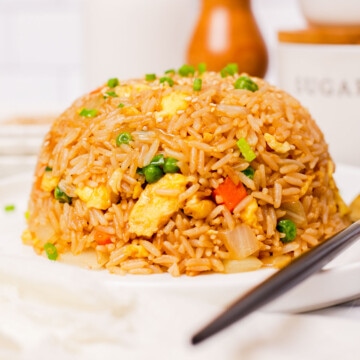
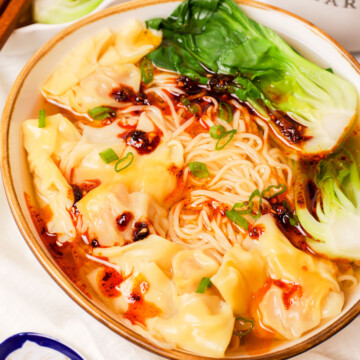
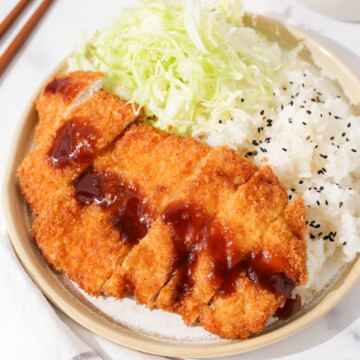
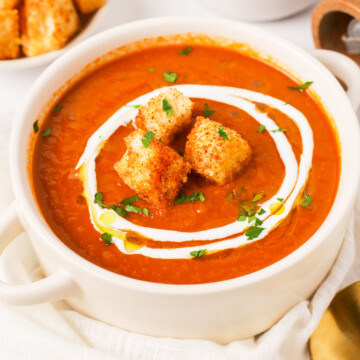
Drop a comment! We'd love to hear from you =)